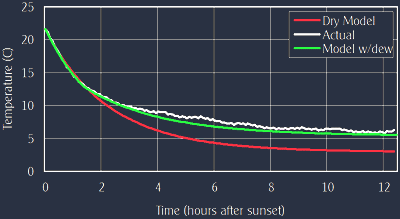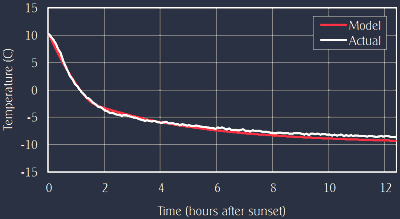Day 78 - Perfect temperature curves?
[sorry if this post is too technical.. I'll be happy to explain some of it later if you'd like]Today was very exciting! I added a simple dew parameterization (that I came up with Sunday on the train) to my model. To my amazement, it yielded a near-perfect fit to the 9/10/05 observations.

Then I dared to run the same exact thing with the initial conditions from 12/04/05, a night when the temperature dropped to 10°C (14°F) at the Micronet. The result: a stunningly accurate forecast for the first few hours, but an underestimation of the temperature once frost started to form. I'm not sure if it was a water vs. ice thing or just the lower temperature. But I tweaked the "condensation" parameter a little and that yielded this: a near-perfect forecast.

This doesn't mean it can forecast temperatures this well. It just means my equations can draw very good temperature curves for one average night and one really cold night. I think that in itself is great progress.
My next tasks: 1) improve the soil temperature forecasts. This should help a little with the air temperature as well. And I don't think it will be hard to do. 2) improve the net radiation estimates/forecasts. That should help the model work better in a wider variety of situations. It's SO great that Reading has a radiation expert!! 3) test it for other nights. After that, the no-turbulence part of the model will be pretty much done. Once the turbulence parameterizations are added, that's when the real magic show should begin - at least I hope.


2 Comments:
I'm glad there are people like you who enjoy doing stuff like this...
I'll build your house for you. That's where I draw the line, though.
:)
Why are you using an "hours after sunset" axis? How are you defining sunset? How many hours of nighttime are there at that point in the year and do you think it would work the same at another point when there is less dark? Or would you just truncate it when the sun began to rise?
Post a Comment
<< Home